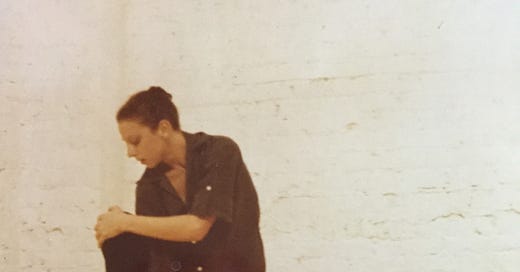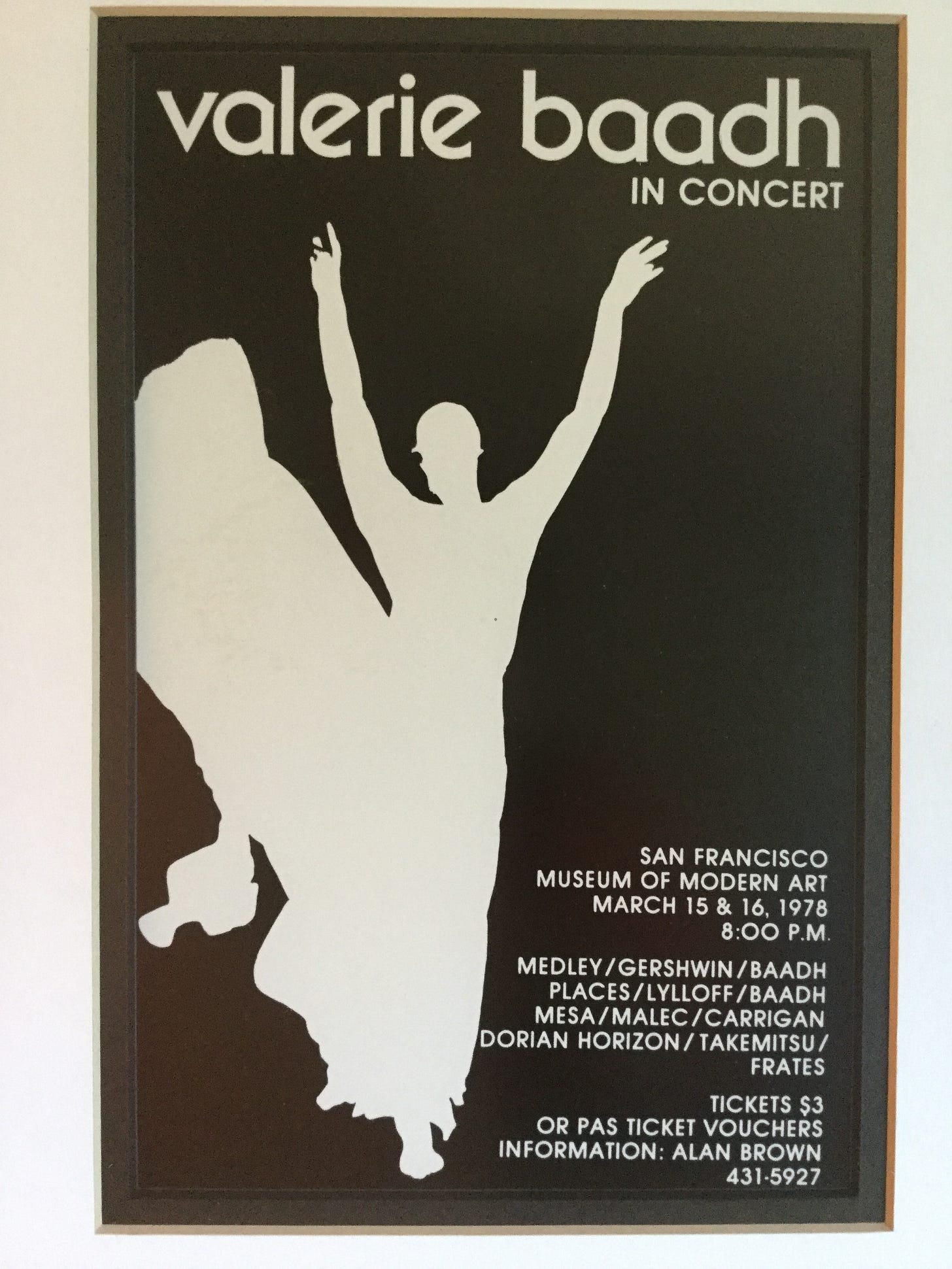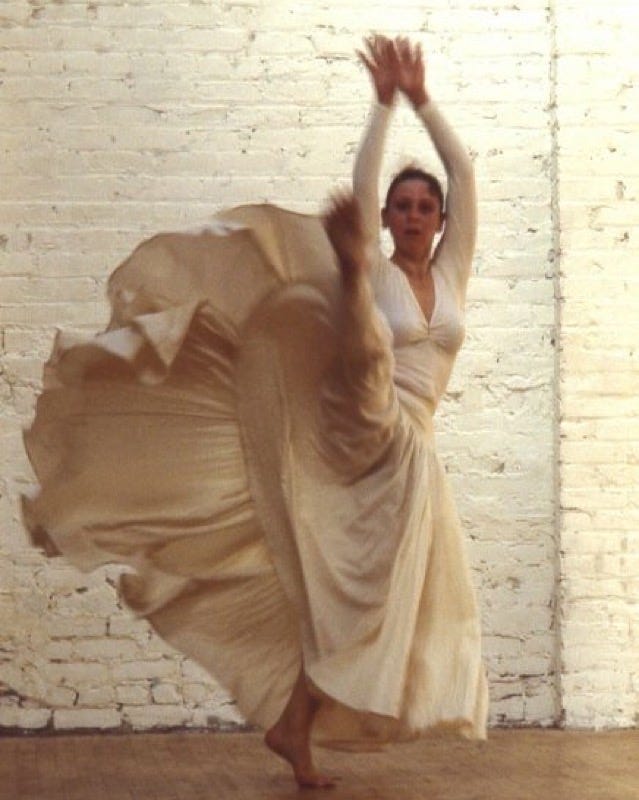S’amazing what the universe sometimes offers up. A dusty cardboard box ignored for decades, seven mysterious video tapes in an obsolete video technology, and a little sleuthing and patience has yielded a vintage artistic bonanza.
In the Beforetimes I spent my life in dance. Dance class, dance clothes, dance shoes, dance shows, dance blues…and dance dreams. Surely the prenatal rhythms of my mother’s heartbeat and my dad’s incessant drumming set a pulse towards music in my body. From the first kiddie recitals, singing and gesturing “I’m a little teapot, short and stout, tip me over and pour me out!” at age three and a culture-appropriating geisha dance at 5 with a red ribbon around my right ankle to keep me in step, I danced.
I got serious, at age 7, at the Palm Springs community center ballet class with a live pianist, 25 cents a lesson. Later, in the mid-1960s, modern dance pioneer Angiola Sartario, from the iconic Kurt Jooss company, offered weekly afternoon classes in the hall of a local trailer park within walking distance from my junior high school. This was the highlight of my week, taking two back to back classes with her and then being invited to assist with the little ones in exchange for tuition.
Time marched on. In high school in Los Angeles and at CalArts, my biggest influence was the brilliant dancer/choreographer/teacher Bella Lewitzky, and the challenging Horton technique she helped develop. Carmen De Lavallade and Alvin Ailey had trained in that same technique in LA years before.
By 1973 I was in San Francisco, exploring other branches of the modern dance tree, choreographing and performing wherever I could while continuing daily ballet classes at Pacific Ballet.
Now we’ve dusted off and unpacked that cardboard box. We recovered and digitalized these barely labeled videos. What’s been revealed are concerts from those early days in San Francisco, including four solos performed at San Francisco Museum of Modern Art.
We can’t remember just how I got on the MOMA arts calender and scored that venue. Somebody knew somebody. There was not even an actual performing space at the old Museum on Van Ness Avenue. Just a magnificent, empty room on the fourth floor.
No worries, said Michael, we’ll just build it.
The stage was 16’ deep by 24’ wide, covered with a black Marley dance floor and backed by black flats left over from a Pacific Ballet production at the Palace of Fine Arts. Everything had to be loaded down a sidewalk elevator into the basement, loaded on carts, pushed across to the elevators and whooshed up to the fourth floor. Michael and his good friend Rick Dimmick made many trips with the heavy carts, nervously dodging priceless art stored in the basement before the stage finally appeared on the top floor.
That 1978 concert was reviewed in the San Francisco Chronicle. Dance critic Alan Ulrich, who was a notably tough sell, made nice comments about the dancing, and pointed out the unusual use of my arms and hands. He was especially taken by “the handsome new performing space” at the Museum. Little did he know that it was gone by Monday.
I can speak and write at great length about each of these dances and all that went into them, but perhaps you’d like to see a couple? We have video! Video we’d never seen before, because no one had playback equipment, then or now. Helical Scan video, the very first Sony reel-to-reel tapes, in black and white. Our regular video conversion lab just shook their heads. Many thanks to Greentree Audio Video in Elizabethtown, PA that had the technology to resurrect these artifacts from our past.
Here’s Half Past Eight, set to four Gershwin piano pieces, 6:46 minutes. Please notice the handsome new performing space.
Here’s Dorian Horizon, inspired by Greek sculpture and myth, 9:48 minutes.
There are more videos of other dances in this series:
Mesa danced by Valerie, SFMOMA, 1978
Places danced by Deborah Frates, Pacific Ballet 1976
Places danced by Valerie, SFMOMA, 1978
Pas de Quatre, choreographed by Valerie, danced by Pacific Ballet, 1977
Special thanks to dance videographer Jed Handler, who did everyone’s concerts on reel to reel video in those early days; stage designer Michael Garrett, who always sets the stage to make me and the dances look good; stage manager Patty Ann Farrell, who called cues, kept me calm, mopped my sweat and got me back onstage when I felt I couldn’t take one more step; Cathy “Cat” Kleinhenz, intrepid stagehand, sound engineer and ultimately my physical therapist; Deirdre Carrigan, a dear and lasting friend, dancer, and yogi, still after 50 years; and the blessed memory of Deborah Frates, RIP, gone too soon.







